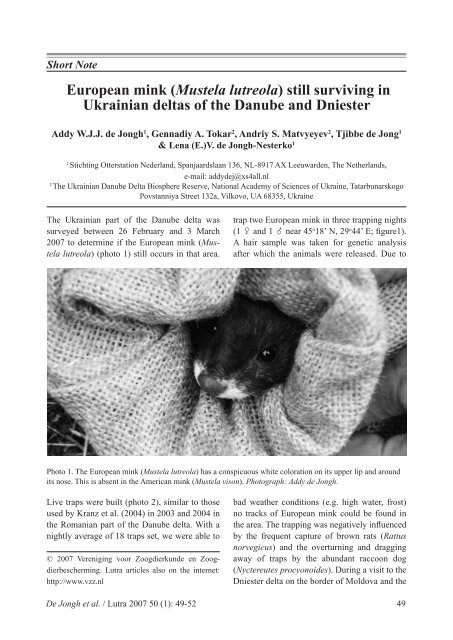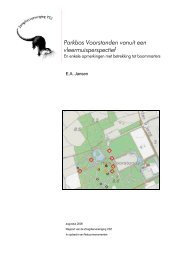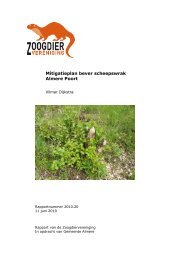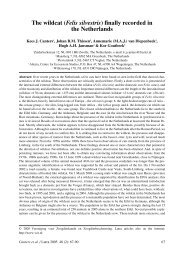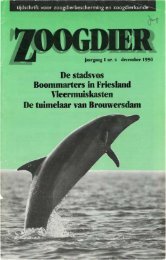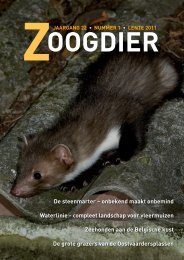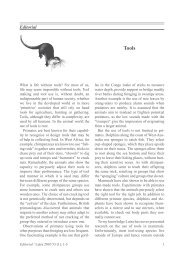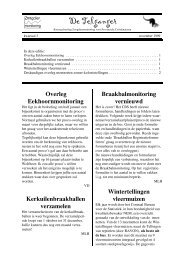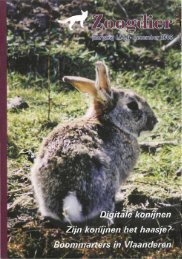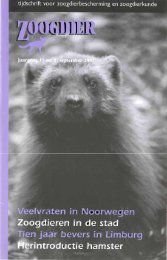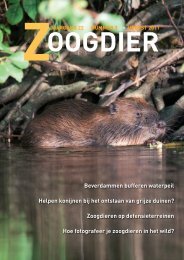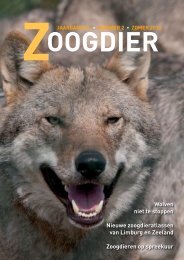European mink (Mustela lutreola) - De Zoogdiervereniging
European mink (Mustela lutreola) - De Zoogdiervereniging
European mink (Mustela lutreola) - De Zoogdiervereniging
- No tags were found...
Create successful ePaper yourself
Turn your PDF publications into a flip-book with our unique Google optimized e-Paper software.
Photo 2. The second <strong>European</strong> <strong>mink</strong> in the live trap. Photograph: Addy de Jongh.Photo 3. The frozen road victim from the Dniester delta. Photograph: Tjibbe de Jong.Ukraine a <strong>European</strong> <strong>mink</strong> road victim was found(photo 3), indicating that a population of <strong>mink</strong>exists in that area as well.Recent introductions of the American <strong>mink</strong>(<strong>Mustela</strong> vison) in the Danube delta are believedto have caused population declines and local extinctionsof <strong>European</strong> <strong>mink</strong>. Males of the American<strong>mink</strong> are able to mate early with <strong>European</strong><strong>mink</strong> females producing resorbed hybrid offspringand could prevent successful reproductionin <strong>European</strong> <strong>mink</strong> (Ternovskij & Ternovskaya1994). American <strong>mink</strong> is more aggressive andproduces more offspring in a single season.Studies with radio telemetry on both <strong>mink</strong> specieshave indicated that <strong>European</strong> <strong>mink</strong> may bechased away from its home range by invadingAmerican <strong>mink</strong> (Sidorovich 1997). The combinationof these two factors has been suggestedto have contributed to the decline of <strong>European</strong><strong>mink</strong> populations (Maran 2007) (figure 2).To assess the risk for <strong>European</strong> <strong>mink</strong> in theUkrainian part of the Danube delta, we questionedtrained foresters in the area. In the Soviettime, there was an American <strong>mink</strong> fur farm in theneighbouring city Izmail. After the collapse ofthe Soviet system the fur farm was dismantled.50 <strong>De</strong> Jongh et al. / Lutra 2007 50 (1): 49-52
Figure 1. Locations in the Danube delta where both<strong>European</strong> <strong>mink</strong> were trapped.The foresters suggested that it was unlikely thatany of these animals survived, and could showthat only <strong>European</strong> <strong>mink</strong> were seen in the area.A biologist specialised in the Dniester ecosystemalso confirmed that <strong>European</strong> <strong>mink</strong> wereliving in this delta, but very low numbers werethought to occur (N.V. Rozhenko, personal communication).The pelt of a <strong>European</strong> <strong>mink</strong> caughthere at the end of the 20th century indicated that<strong>European</strong> <strong>mink</strong> occurred in this delta around tenyears ago. There were no indications of American<strong>mink</strong> in this area. A decline in the <strong>European</strong><strong>mink</strong> population was thought to be the result ofa newly constructed dam on the river Dniester(further north in Moldova) which regulates thewater level and negatively influences the <strong>mink</strong>’shabitat. The dam mainly reduced fluctuations inwater levels of the river, negatively affecting thefood resources of the <strong>European</strong> <strong>mink</strong> (N.V. Rozhenko,personal communication).We will continue research in both deltas, withthe aim of enhancing our understanding of theoccurrence and population size of <strong>European</strong><strong>mink</strong>. <strong>De</strong>pending on our findings, a telemetrystudy will be set up to improve our knowledgeabout home ranges and daily activities of thisspecies. A rescue plan for the survival of the <strong>European</strong><strong>mink</strong> in this region needs to be developedurgently.Acknowledgements: We thank Alexander Voloshkevych,director of the Ukrainian Danube <strong>De</strong>ltaBiosphere Reserve, for his hospitality, help and advice.We also thank the foresters of the reserve for theircompany, friendship and willingness to cooperate. Weare grateful for the important input of Mr. Tokar senior,the father of one of the authors, for his rapid andprofessional construction of the live traps. Last but notleast, we are grateful for the equipment and adviceprovided by our Irish colleague Lughaidh Ó Néill.Figure 2. The historical and present geographicdistribution of the <strong>European</strong> <strong>mink</strong>. Note the releasedpopulations on the large Estonian islands of Saaremaaand Hiiumaa.ReferencesKranz, A., A. Toman, Marinov, M. & J.B. Kiss 2004.<strong>European</strong> <strong>mink</strong> research: Results of the spring2004 expedition. Scientific Annals of the Danube<strong>De</strong>lta Institute for Research and <strong>De</strong>velopment,Tulcea – Romania 2005: 42-44.<strong>De</strong> Jongh et al. / Lutra 2007 50 (1): 49-52 51


